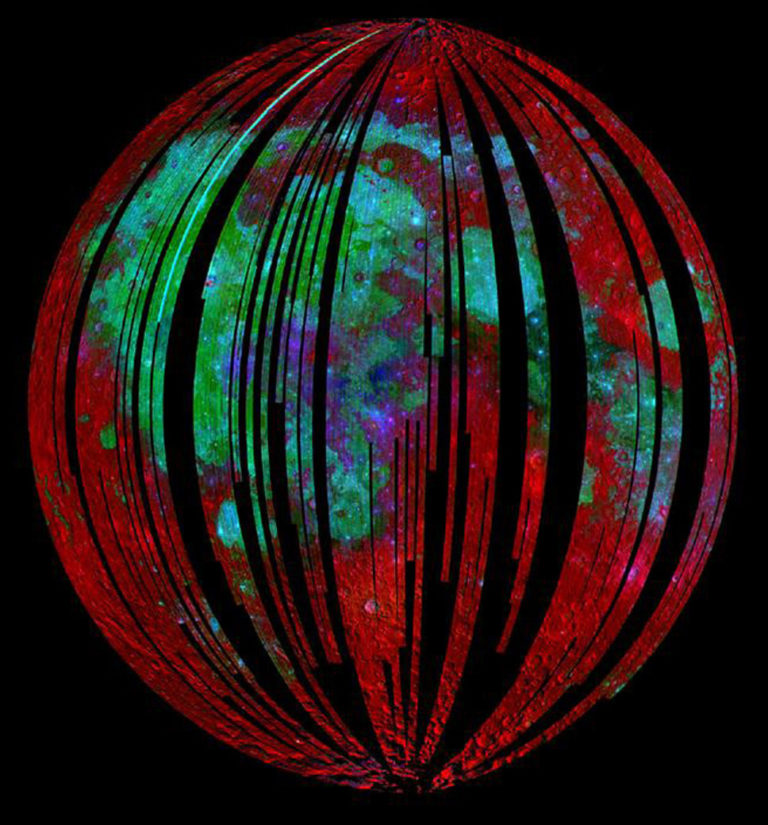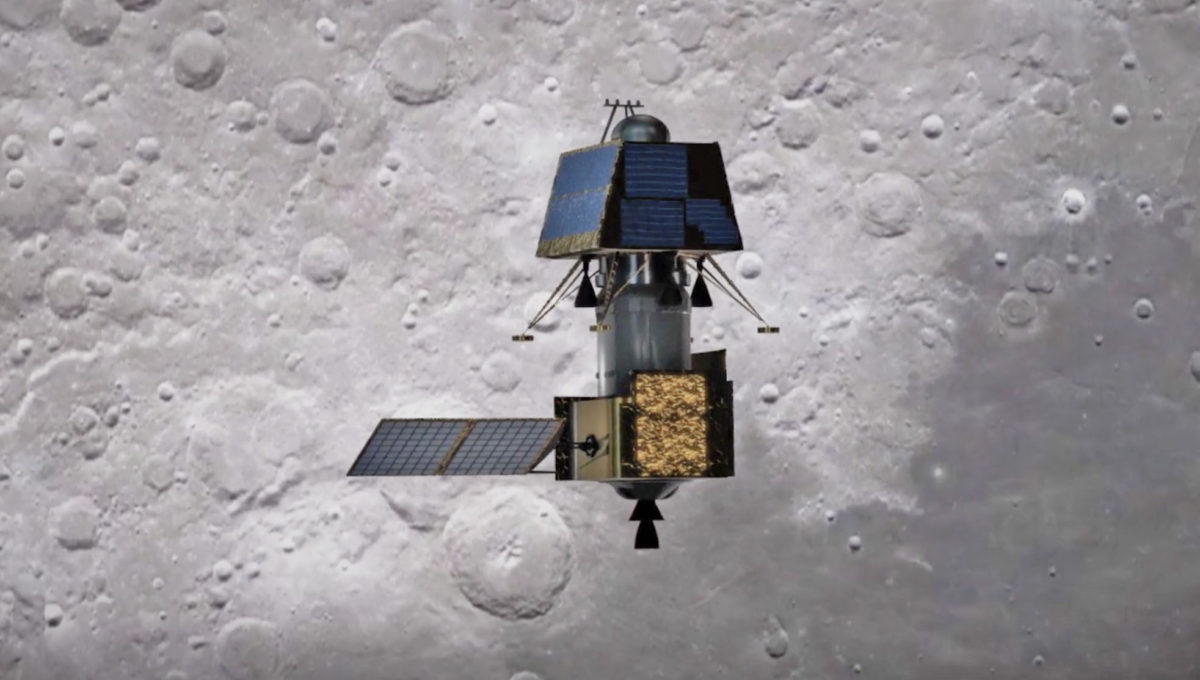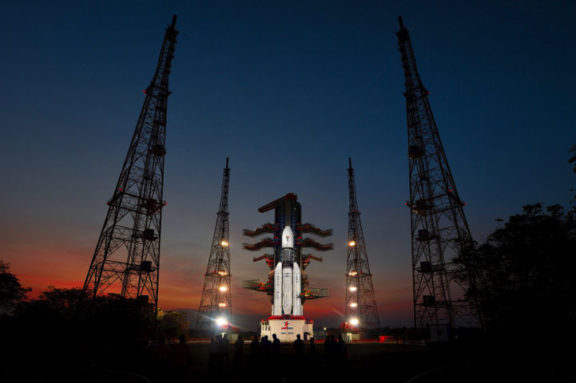Sridhar Narayanan • Jul 08, 2019
What to Expect when Chandrayaan-2 Launches to and Lands on the Moon
Launch day is less than a week away for India’s Chandrayaan-2 Moon orbiter, lander and rover. This is the second mission to the Moon for ISRO, the Indian Space Research Organization. Liftoff is scheduled for 14 July 2019 at 21:21 UTC (15 July 2019 at 02:51 IST local time), atop a GSLV-MK3 launcher from the Satish Dhawan Space Centre on the east coast of India.
Update: The launch was scrubbed 56 minutes prior to liftoff due to a suspected helium leak in the upper stage engine. Launch is now scheduled for 21 July 2019 at 21:13 UTC (22 July 2019 at 02:43 IST local time).
ISRO typically hosts a live video stream of the launch that can be accessed from their webpage. You can also look for launch coverage on the YouTube page of India's national broadcaster, Doordarshan.
Chandrayaan-2, India's Moon orbiter
India's Chandrayaan-2 spacecraft studies the composition of the Moon's surface and searches for signatures of water ice.
If everything goes according to plan, the launcher will inject the spacecraft into an elliptical earth parking orbit with a perigee, or low point, of 170 kilometers and an apogee, or high point, of 40,400 kilometers. A series of orbit raising maneuvers will progressively raise the apogee of the spacecraft until it can be captured by the Moon’s gravity with an engine burn. Chandrayaan-2 will then perform a series of orbital maneuvers to reach a circular, 100-kilometer orbit around the Moon. The next phase of the mission involves separating the Vikram lander unit from the orbital unit of the spacecraft, and landing Vikram near the Moon’s south pole on 6 September 2019. The third phase of the mission involves the roll out of the Pragyan rover from the Vikram lander, and a subsequent 14-day mission for the rover involving various experiments.
The GSLV-MK3 launcher has already been integrated in the Vehicle Assembly building at the Satish Dhawan Space Center at Sriharikota on the eastern coast of India.
Chandrayaan-1
Chandrayaan-2 is India’s second mission to the Moon. The first, Chandrayaan-1, was launched on 22 October 2008, and included an orbiter and a Moon impact probe—a small module that separated from the orbiter and impacted the Moon near Shackleton crater. The orbiter included several scientific instruments for creating a three-dimensional map of the Moon and analyzing its mineral composition. The spacecraft went into orbit around the Moon on 8 November 2008, and the Moon impact probe crash-landed on 14 November 2008. The instruments in the orbiter were subsequently activated, and operated normally for the next 10 months.
While it did not complete its mission life of 2 years, the Chandrayaan-1 mission had several achievements. It was the first interplanetary mission for ISRO, and heralded the way for other missions to follow, including one to Mars, and the upcoming Chandrayaan-2 mission. Its most significant scientific achievement was the discovery of water on the Moon. First, a mass spectrometer on the Moon Impact Probe detected water in the thin lunar atmosphere. Then, the Moon Mineralogy Mapper instrument, developed by NASA and carried on the orbiter, detected water ice on the surface near the lunar poles. Additionally, the mini-SAR synthetic aperture radar developed by NASA and carried on the orbiter also found evidence consistent with the presence of water ice at the lunar north pole. Other achievements of the mission include the creation of detailed three-dimensional maps using over 70,000 images taken by its cameras, a study of the process by which water may form on the Moon, and a study of past tectonic activity on the Moon.

Chandrayaan-2
The Chandrayaan-2 mission is ISRO’s second mission to the Moon, and the agency’s third interplanetary mission after Chandrayaan-1 and the Mars Orbiter Mission, which launched in November 2013 and entered Mars orbit in September 2014.
Chandrayaan-2 consists of three main components. The first, also with the same name as the overall mission, is the orbiter. This will carry the other two components and will be placed in a circular lunar orbit, at an altitude of 100 km above the lunar surface. The second is the Vikram lander, which will be soft-landed on the surface, and will carry a set of instruments to conduct scientific experiments. The third will be the Pragyan rover carried aboard Vikram, which will be deployed onto the surface. This autonomous vehicle will carry its own set of instruments to conduct experiments over a planned 14-day life span.
The landing site for Vikram and Pragyan is near the lunar south pole, at about 70° south latitude, though other reports have indicated landing sites even closer to the south pole.
Chandrayaan-2 Orbiter

The Chandrayaan-2 orbiter, which will weigh 2,379 kilograms at launch, will carry a propulsion module including a liquid propulsion engine and onboard fuel for raising its orbit from the initial elliptical earth parking orbit in which it will be placed after launch. A series of orbit raising burns of its liquid engine will raise its orbit until it reaches a lunar transfer trajectory, where its orbit will bring it close enough to the Moon to be captured by lunar gravity. A series of burns will then lower its orbit to a 100-kilometer circular lunar orbit. The engine onboard the orbiter will also be used for maintaining this orbit during the course of the mission.
The second function of the orbiter will be to carry the lander-rover module and release it for its soft landing. A high-resolution camera aboard Chandrayaan-2 will image the planned landing site to help fine-tune the landing phase of the mission. It will also carry communication equipment to facilitate communications between the lander and rover, and the mission control center on earth. The orbiter's primary mission will last 1 year.
In addition to carrying the lander and rover, and supporting the landing part of the mission, the orbiter will carry a set of eight scientific payloads. You can read more about these on The Planetary Society’s Chandrayaan-2 mission page.
Vikram Lander

The Vikram lander is named after the founder of ISRO and the Indian space program, Dr. Vikram Sarabhai. It will weigh 1,471 kilograms at launch, and will carry the Pragyan rover. After separation from the orbiter, Vikram will conduct a set of burns to de-boost from lunar orbit, and conduct a soft-landing on the surface. The lander has two roles in the rover part of the mission: to carry the rover to the Moon’s surface, and to serve as a communication relay between the rover, orbiter, and Earth. Additionally, the lander carries instruments to conduct three scientific experiments and take measurements for 14 Earth days ater landing.
Pragyan Rover

The Pragyan (Sanskrit for wisdom) rover is a 27 kilogram, 6-wheeled robotic vehicle with the ability to move autonomously within a 500m radius of the landing site. It has a 50-watt solar panel for powering its propulsion system, scientific instruments and communication equipment. Its mission life is one lunar day, or 14 earth days, during which it will explore the area around the landing site with its instruments. An attempt will be made to revive the rover after the lunar night.
GSLV-MK3 launcher

The GSLV-MK3 launcher will insert the Chandrayaan-2 spacecraft into its initial earth parking orbit. This is the most powerful launcher developed by ISRO, and has conducted two successful launches to date. Its first successful orbital launch was conducted on 5 June 2017, when it launched an experimental geostationary communication satellite named GSAT-19. Originally designed to launch ISRO’s heavier satellites into earth orbit, it is also the designated launcher for India’s planned Gaganyaan human spaceflight missions. Chandrayaan-2 spacecraft was originally planned to be launched on the less-powerful GSLV launcher, but a change in the mission parameters and the weights of the orbiter, lander and rover led to a change in the launcher as well.
The GSLV-MK3 is a 3-stage rocket, consisting of a pair of S-200 solid boosters that are lit at the time of liftoff, a core liquid L-110 stage that burns hypergolic liquid fuel, and a CE-20 cryogenic upper stage that uses liquid hydrogen as fuel. Chandrayaan-2 will be the first interplanetary mission for the powerful launcher.
Support our core enterprises
Your support powers our mission to explore worlds, find life, and defend Earth. You make all the difference when you make a gift. Give today!
Donate

 Explore Worlds
Explore Worlds Find Life
Find Life Defend Earth
Defend Earth


